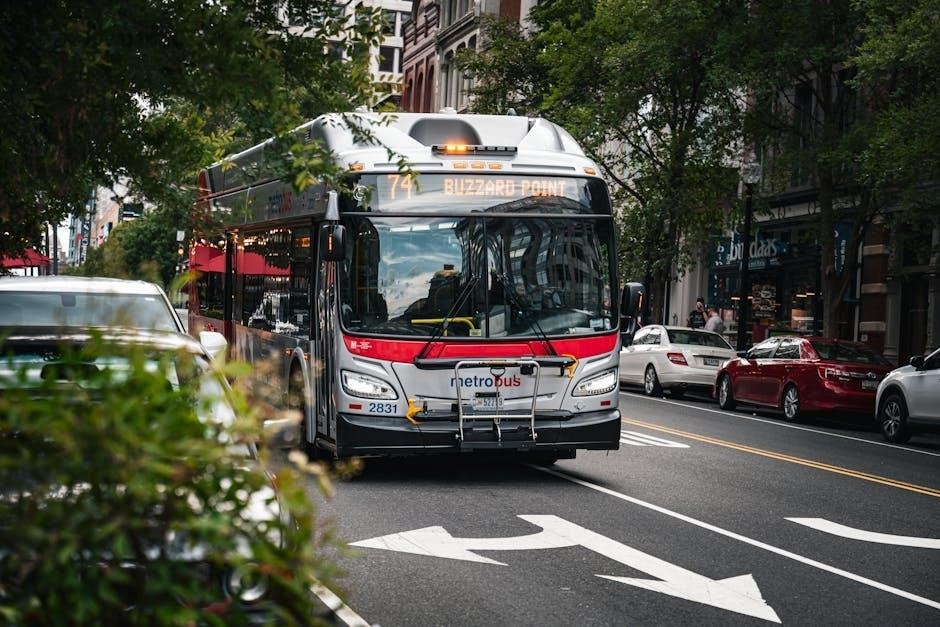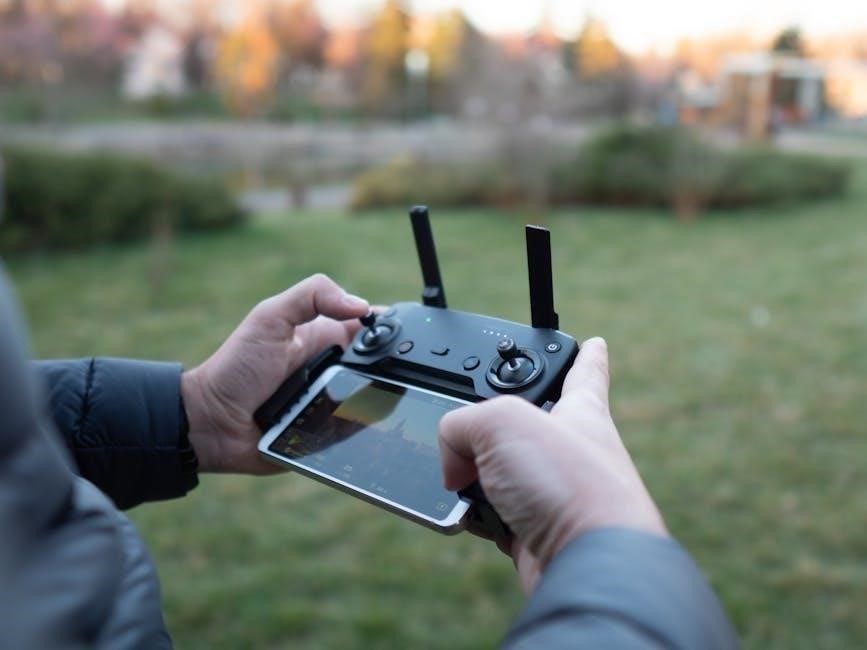Firearms in D&D 5e introduce a unique blend of historical and fantasy combat, offering players new tactical options. While official rules are limited, homebrew content like Firearms 5e provides detailed mechanics, including damage types, ranges, and reload times, allowing DMs to integrate guns seamlessly into their campaigns. This section explores the basics of firearms, their role in gameplay, and the resources available for crafting custom rules and weapons.
1.1 Brief Overview of Firearms in D&D 5e
Firearms in D&D 5e add a unique layer of strategy and excitement to combat. While official rules are sparse, homebrew content like the Firearms 5e PDF expands on their use, detailing weapons such as muskets, flintlock pistols, and even modern firearms. These weapons often require specific classes, like the Gunslinger, to wield effectively. Firearms introduce mechanics like reload times, burst fire, and critical hits, blending historical and fantasy elements. They also come with risks, such as misfires, adding depth to gameplay. Ammunition and weapon crafting further enrich the experience, making firearms a versatile and dynamic addition to any campaign.

1.2 Popularity of Firearms in D&D 5e Homebrew
Firearms have gained significant popularity in D&D 5e homebrew due to their unique gameplay mechanics and versatility. Players enjoy the high-risk/high-reward nature of weapons like muskets and flintlock pistols, which offer tactical depth. Homebrew settings often make firearms accessible to low-level characters, enhancing early-game combat. The ability to craft custom rules, such as modifiers for range and reload times, attracts DMs seeking to differentiate their campaigns. Additionally, the availability of detailed PDF resources, like Firearms 5e, has fueled community-driven innovation, making firearms a staple in many custom adventures.
1.3 Historical Context of Firearms in D&D 5e
Firearms in D&D 5e draw inspiration from historical weapons like muskets and flintlock pistols, reflecting their real-world evolution. These weapons, prevalent in the 16th to 18th centuries, were revolutionary for their time. In D&D, firearms are often depicted as rare or experimental, fitting into low-magic settings. The Firearms 5e PDF highlights their integration into fantasy worlds, blending historical accuracy with fantasy elements. This approach allows DMs to craft unique narratives, balancing firearms’ power with the game’s medieval-inspired aesthetics.
The Gunsmith Subclass in D&D 5e
The Gunsmith, an Artificer subclass, specializes in crafting and utilizing firearms, blending technical expertise with combat prowess, offering unique playstyles in D&D 5e campaigns.
2.1 Overview of the Gunsmith Subclass
The Gunsmith is an Artificer subclass in D&D 5e, focusing on mastering firearms and explosive devices. This subclass emphasizes invention and precision, allowing players to craft, modify, and wield firearms with unique proficiency. Gunsmiths blend technological ingenuity with combat prowess, making them versatile ranged attackers. Their abilities highlight resourcefulness, enabling them to adapt to various combat scenarios while relying on their crafted weapons. This subclass offers a distinct playstyle, combining creativity with deadly accuracy, making it a compelling choice for players seeking a blend of innovation and firepower.
2.2 Key Features of the Gunsmith Subclass
The Gunsmith subclass offers unique abilities tailored for firearm specialists. Firearm Expertise grants proficiency and enhanced attacks with guns. Explosive Attacks allow for area damage, while Smoke Screen provides tactical cover. Gunsmith’s Craft enables crafting and modifying firearms, ensuring versatility. These features make the Gunsmith a master of ranged combat, combining precision with explosive force. The subclass emphasizes tactical play and resource management, appealing to players who enjoy strategic combat and invention.
2.3 Balancing the Gunsmith Subclass in Campaigns
Balancing the Gunsmith subclass requires careful consideration of its offensive and utility capabilities. To prevent overshadowing other classes, DMs can adjust firearm damage output or introduce optional rules like increased reload times. Modifying the frequency of Explosive Attacks or limiting access to advanced firearms at lower levels can also maintain game equilibrium. Additionally, encouraging players to use firearms strategically rather than excessively helps preserve the subclass’s uniqueness without disrupting party dynamics.
Firearms Rules and Mechanics
Firearms in D&D 5e are handled as ranged weapons with unique properties. They deal firearm damage, have specific ranges, and require ammunition to function.
3.1 Damage Types and Ranges of Firearms
Firearms in D&D 5e primarily deal piercing or bludgeoning damage, depending on the weapon type. Their ranges vary, with most firearms falling into close, medium, or long range categories. Close-range firearms are effective within 30 feet, while medium-range weapons extend up to 150 feet. Long-range firearms, such as muskets, can reach up to 600 feet. Attack rolls with firearms may gain advantage or disadvantage based on range, balancing their potency in combat scenarios.
3.2 Reload Times and Ammunition
Firearms in D&D 5e have specific reload times, typically requiring a bonus action to reload, though some weapons, like the handloader, allow for faster reloading with certain feats. Ammunition types include lead bullets, chain shot, and explosive rounds, each with unique effects. Firearms can hold varying amounts of ammunition, and reloading often involves managing limited resources; Proper storage and handling of ammunition are crucial, as mishandling can lead to accidents. These mechanics add depth to firearm usage, balancing accessibility with strategic planning in combat scenarios.
3.4 Burst Fire and Automatic Attacks
Firearms in D&D 5e can utilize burst fire or automatic attacks, often requiring the Extra Attack feature to activate. Burst fire allows a character to fire 3-4 bullets in a single attack, dealing increased damage but consuming more ammunition. Automatic attacks, meanwhile, enable sustained fire, potentially targeting multiple enemies within a cone or area. These mechanics add tactical depth, allowing players to trade precision for volume of fire, though they often come with resource management challenges and risks of overheating or jamming weapons.

Homebrew Firearms Rules
Homebrew rules expand firearm customization, offering unique damage systems, ammunition types, and weapon modifications. These community-driven options enhance gameplay flexibility and realism, appealing to players seeking diverse firearm mechanics.
4.1 High-Risk/High-Reward Firearms Rules
These homebrew rules introduce unpredictable firearm mechanics, balancing power with danger. Critical hits deal massive damage, while misfires trigger explosive consequences. Players can gamble on high-risk shots for devastating effects, but face penalties like weapon jamming or ammo loss. Optional rules include “lucky shots” granting advantage or “catastrophic failures” causing harm to allies. This system adds excitement and strategic depth, rewarding daring playstyles while maintaining game balance through inherent risks.
4.2 Affordable Firearms for Low-Level Characters
Homebrew rules can make firearms accessible to low-level characters without disrupting balance. Adjusting costs and availability allows early adoption of pistols or muskets. These firearms could have reduced damage or limited ammo to keep them viable but not overpowered. Optional rules might include crafting simple firearms or finding them as treasure. This enables players to experiment with gunplay early on, adding variety to combat without overshadowing traditional weapons. Balancing affordability ensures firearms remain fun yet fair for all party members.
4.3 Modifiers for Firearms as a Class Feature
Homebrew rules can tie firearm proficiency to class features, enhancing playstyles. For example, rogues might gain sneak attack damage with pistols, while fighters could improve critical ranges. Modifiers like Precision Shooting or Quick Reload can be class-exclusive, adding depth. These features incentivize choosing firearms over traditional weapons, rewarding strategic use. Balancing these modifiers ensures they don’t overshadow other class abilities, keeping gameplay fair and engaging for all players.
Specific Firearms in D&D 5e
Specific firearms like the musket and hand cannon are detailed in the Dungeon Master’s Guide. These weapons offer unique mechanical traits, blending historical charm with fantasy combat, adding depth to D&D 5e battles.

5.1 Muskets and Flintlock Pistols
Muskets and flintlock pistols are iconic firearms in D&D 5e, offering a blend of historical charm and tactical combat. Muskets are powerful, long-range weapons, often dealing 1d12 damage, while flintlock pistols provide 1d10 damage at shorter ranges. Both weapons emphasize accuracy and require reloading, adding strategic depth. Their mechanical complexity, including misfire chances, enhances immersion. These firearms are popular in homebrew settings, allowing players to wield weapons with a historical feel, balancing risk and reward in combat scenarios.
5.2 Gatling Gun and Its Requirements
The Gatling Gun is a revolutionary firearm in D&D 5e, offering rapid, high-volume firepower. To wield it, characters typically need Strength 13 or higher and proficiency with heavy weapons. It deals 2d6 force damage per burst, with a range of 800/3,200 feet. However, its weight and size require a tripod for stability, and reloading its ammo belt is time-consuming. DMs often restrict its use to specific campaigns or high-level play due to its overwhelming combat potential and historical inaccuracy in medieval settings.
5.3 Explosives and Special Weapons
Explosives and special weapons add a dynamic layer to D&D 5e combat. Grenades, dynamite, and other deal massive area damage, often applying status effects like blindness or deafness. Magical explosives, such as fireballs or ice storms, can be crafted using the Tinkerer feat or homebrew rules. These weapons require careful balancing to avoid overshadowing traditional spells and abilities. DMs often restrict their use to specific scenarios or high-stakes encounters, ensuring they enhance gameplay without disrupting balance. Their rarity and potency make them thrilling yet manageable additions to adventures.

The Role of Firearms in Campaign Settings
Firearms redefine combat dynamics, offering strategic depth and narrative richness while requiring careful balance to maintain game harmony and immersion in diverse campaign settings.
6.1 Firearms in Homebrew Settings
Firearms in homebrew settings offer unparalleled customization, allowing DMs to craft unique worlds where guns complement the narrative and setting. From pirate adventures to Wild West-inspired campaigns, homebrew settings provide the flexibility to integrate firearms seamlessly. Players can customize weapons, creating distinctive playstyles; The presence of firearms adds a layer of strategic combat, encouraging tactical thinking. This integration enhances the game’s flavor, making each encounter more immersive. Homebrew settings allow for creative balancing, ensuring firearms are fun without overshadowing magic or melee combat. Innovation thrives in these custom worlds, making firearms a dynamic element in storytelling and gameplay.
6.2 Firearms in Official Campaigns
Firearms in official D&D 5e campaigns are rare and often treated as optional or setting-specific elements. They are balanced to maintain game equilibrium, ensuring they don’t overshadow traditional weapons or magic. Official sources like the Dungeon Master’s Guide provide limited firearm rules, emphasizing their scarcity and unique role in certain narratives. These mechanics are designed to integrate seamlessly without disrupting the game’s core dynamics, allowing DMs to introduce firearms in a controlled manner that enhances the story and setting.
6.3 Impact of Firearms on Game Balance
Firearms can significantly alter the balance of a D&D 5e campaign, as they introduce ranged weapons with high damage potential. This can overshadow traditional weapons and spells, potentially disrupting the game’s equilibrium. DMs must carefully manage firearm availability and power to prevent them from dominating encounters. Players may favor firearms over other options, shifting combat dynamics and strategies. Balancing requires limiting access, adjusting damage output, or introducing countermeasures to ensure fairness and maintain the game’s intended challenge and fun for all players.
Crafting and Customization
Crafting firearms involves skill checks like Perception or Intelligence, requiring rare materials. Customization enhances performance or appearance, such as engravings or unique mechanisms, adding lore and functionality.
7.1 Crafting Firearms and Ammunition
Crafting firearms and ammunition requires proficiency in specific skills, such as Dexterity or Wisdom checks. Materials like metal, wood, and gunpowder are essential. Crafting times vary, from days for simple weapons to weeks for complex ones. DMs can set DCs based on weapon rarity, using the Dungeon Master’s Guide as a reference. Optional rules may include misfire chances on failed checks, adding realism. This process allows players to create unique firearms tailored to their playstyle, enhancing both utility and narrative depth in the game.
7.2 Customization Options for Firearms
Customization options for firearms in D&D 5e allow players to tailor weapons to their characters’ needs. Modifications like enhanced barrels, custom stocks, or scopes can improve accuracy or range. Enchantments, such as firearm-specific magic, can add unique effects like flaming bullets or silent shots. Players can also swap parts like barrels or triggers to adapt firearms for different combat scenarios. These customizations often require crafting skills or rare materials, ensuring balance while offering creative flexibility for players to personalize their weapons.
7.3 Unique Ammunition Types
Unique ammunition types in D&D 5e firearms add versatility to combat. Explosive rounds deal area damage, while armor-piercing bullets ignore armor class bonuses. Smoke rounds create cover, and tracer bullets improve ranged attacks. Magical ammo, like dragonfire bullets, unleash elemental effects. Players can craft or discover these specialized rounds, adding depth to firearm tactics. Each type offers strategic advantages, encouraging players to adapt their ammo choices to enemies and environments, enhancing gameplay depth and flexibility in combat scenarios.

The Gunslinger Subclass
Introducing the Gunslinger, a subclass that brings firearm mastery to D&D 5e, offering unique shooting styles and abilities that blend precision and power in combat scenarios.
8.1 Overview of the Gunslinger Subclass
The Gunslinger subclass introduces a new archetype focused on mastery of firearms, blending precision, mobility, and tactical combat. It offers customization options like shooting styles and combat maneuvers, allowing players to craft unique ranged specialists. Designed to fit seamlessly into D&D 5e, the Gunslinger brings a fresh playstyle that emphasizes ranged superiority and strategic positioning. Perfect for campaigns embracing firearms, this subclass appeals to players seeking a blend of finesse and firepower in their adventures, whether in historical or modern settings.
8.2 Key Features of the Gunslinger Subclass
The Gunslinger subclass offers unique abilities that define its playstyle. Key features include Precision for consistent accuracy, Special Techniques like rapid firing or aimed shots, and Gunsmith to craft and modify firearms. Players gain access to Combat Maneuvers that enhance mobility and tactical options. The subclass emphasizes versatility, allowing characters to excel in ranged combat while maintaining a dynamic, high-action playstyle that complements both historical and modern campaign settings.
8.3 Playstyle and Strategy for Gunslingers
Gunslingers excel at ranged combat, emphasizing precision and mobility. Players should focus on positioning, using cover, and managing ammunition effectively. The subclass thrives in dynamic battles, where quick repositions and clever use of abilities like Precision and Special Techniques can turn the tide. Gunslingers are versatile, capable of dealing consistent damage or providing tactical support. They shine in campaigns with a mix of ranged and close-quarters encounters, allowing for strategic flexibility and creative problem-solving.

Firearms in Modern and Historical Campaigns
Firearms add a unique twist to both modern and historical D&D campaigns, blending traditional fantasy with realistic weaponry, creating diverse combat scenarios and rich storytelling opportunities.
9.1 Modern Guns in D&D 5e
Modern guns like assault rifles and sniper rifles bring a new layer of strategy to D&D 5e, offering long-range precision and high damage output. These weapons often require homebrew rules to balance their power in a fantasy setting. Players can craft custom firearm builds, combining modern weaponry with magical enhancements. However, integrating modern guns demands careful consideration of campaign tone and game balance to ensure they don’t overshadow traditional weapons. This blend of modern and medieval combat creates a unique, dynamic gameplay experience for adventurers.
9.2 Historical Firearms in D&D 5e
Historical firearms like flintlock pistols and muskets add a unique flavor to D&D 5e campaigns, offering a blend of realism and fantasy. These weapons, inspired by real-world history, often come with specific reload mechanics and limited ammunition. They provide a tactical advantage in combat, especially at range. Incorporating historical firearms into a campaign setting can enhance immersion, allowing players to wield weapons reminiscent of the Renaissance era. DMs can balance these arms by adjusting damage output and availability, ensuring they complement the game’s medieval-fantasy aesthetic while maintaining fairness for all players.
9.3 Blending Modern and Medieval Combat
Blending modern and medieval combat in D&D 5e creates a dynamic setting where ancient weaponry coexists with firearms. This fusion allows players to experiment with diverse playstyles, combining spellcasting with gunplay or traditional melee with ranged firepower. DMs can craft unique encounters where knights face off against gunmen, or mages adapt their spells to counter firearms. Balancing these elements is crucial to maintain game harmony, ensuring neither style overshadows the other. This blend enriches storytelling and offers players innovative ways to approach challenges, enhancing the game’s versatility and depth.

Challenges and Controversies
Firearms in D&D 5e spark debates over balance, lore consistency, and player fairness, often clashing with traditional fantasy elements and causing tension in gameplay dynamics.
10.1 Balancing Firearms in D&D 5e
Firearms in D&D 5e present balancing challenges, as their ranged lethality can overshadow traditional weapons like bows or swords. High damage output and long-range capabilities often make them more potent than medieval arms, disrupting game balance. Additionally, reload mechanics and limited ammunition require careful handling to prevent firearms from becoming overly restrictive or dominant. DMs must weigh these factors to ensure fairness, often tweaking homebrew rules to align with the game’s fantasy setting and maintain equilibrium among player classes and abilities.
10.2 Controversies Surrounding Firearms in D&D
Firearms in D&D 5e spark debate due to their clash with the game’s medieval fantasy roots. Critics argue they disrupt the traditional magic-and-martial balance and overshadow iconic weapons like swords or bows. Others contest their historical inaccuracies in fantasy settings, while some players demand realistic gun mechanics for immersion. Additionally, the moral implications of firearms, such as their lethal nature, fuel discussions about their place in a game centered on heroism and storytelling. These debates highlight the tension between innovation and preserving D&D’s core identity.
10.3 Addressing Player Concerns About Firearms
Addressing player concerns about firearms involves balancing game mechanics with narrative consistency. Many players worry about firearms overshadowing traditional weapons or disrupting the game’s fantasy setting. DMs can alleviate these concerns by establishing clear lore-friendly rules and ensuring firearms are neither overpowered nor mandatory. Encouraging player feedback and incorporating their preferences into custom firearm rules helps maintain harmony at the table. Providing optional homebrew adjustments and ensuring transparency in their implementation fosters trust and engagement among the party. This approach ensures firearms enhance, rather than detract from, the D&D experience.

Firearms in Official D&D 5e Publications
Official D&D 5e publications like the Dungeon Master’s Guide include limited firearm rules, balancing fantasy with historical elements. These rules provide a foundation for integration while maintaining game harmony.
11.1 Firearms in the Dungeon Master’s Guide
The Dungeon Master’s Guide includes basic rules for firearms, presenting them as rare and powerful weapons in a fantasy setting. Found in the “Weapons” section, these rules provide damage types, ranges, and loading times, emphasizing their limited availability. Firearms are balanced to fit within D&D’s magic-dominated world, with specific restrictions on acquisition and use. The DMG’s approach ensures firearms don’t overshadow traditional weapons, making them niche options for certain campaigns. This framework allows DMs to integrate firearms thoughtfully without disrupting game balance.
11.2 Firearms in Other Official Sources
Beyond the Dungeon Master’s Guide, official D&D 5e sources rarely mention firearms. Books like Xanathar’s Guide to Everything and The Sword Coast Adventurer’s Guide briefly acknowledge firearms but don’t expand on their rules. Guildmasters’ Guide to Ravnica touches on firearms in its modern setting, offering limited options. These sources treat firearms as niche or optional, leaving detailed rules to homebrew or third-party content. This sparse coverage reflects Wizards of the Coast’s cautious approach, allowing DMs to decide whether and how to incorporate firearms into their campaigns.
11.3 Official Rules vs. Homebrew Adaptations
Official D&D 5e rules for firearms, primarily found in the Dungeon Master’s Guide, are minimal and often vague. They provide basic guidelines for firearms like muskets and pistols but lack depth. In contrast, homebrew adaptations offer extensive customization, detailed mechanics, and balanced options for players. While official rules cater to simplicity, homebrew content expands on firearm types, ammunition, and unique features, allowing for richer gameplay experiences. This divergence highlights the flexibility of homebrew compared to the limited official framework, making homebrew a popular choice for firearm enthusiasts in D&D 5e campaigns.

The Future of Firearms in D&D 5e
The future of firearms in D&D 5e likely involves official support, community-driven homebrew, and rule evolution based on player feedback and game balance considerations.
12.1 Community Demand for Firearms Content
The community’s demand for firearms content in D&D 5e remains strong, driven by players seeking unique playstyles and historical or modern combat elements. Homebrew creators continue to develop detailed firearm rules, including PDF resources and custom subclasses, to fill the gap left by limited official support. This demand reflects a desire for more diverse combat options and immersive settings, encouraging both official and community-driven innovations in the game. The popularity of firearm-centric homebrews highlights the potential for official integration in future publications.
12;2 Potential Official Support for Firearms
While Wizards of the Coast has not officially embraced firearms in D&D 5e, the growing popularity of homebrew firearm rules and player demand suggests potential future support. Official integration would require careful balance to maintain game harmony, likely through playtesting and community feedback. The success of firearms PDF resources and subclasses indicates a market for such content. If introduced, official firearm rules could blend seamlessly with existing mechanics, offering players new tactical options while preserving the game’s core identity.
12.3 Evolving Homebrew Rules for Firearms
Homebrew firearm rules in D&D 5e continue to evolve, driven by community feedback and creative experimentation. Players and DMs refine mechanics to enhance balance and fun, often sharing their innovations in firearms PDF resources. These rules adapt to new playstyles, incorporating feedback from campaigns and online forums. As a result, homebrew firearm systems grow more diverse, offering options like custom ammunition, unique weapon traits, and specialized combat maneuvers. This collaborative evolution ensures firearms remain a dynamic and engaging element in D&D 5e, tailored to individual campaign needs;
